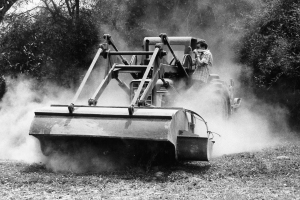From the earliest days of MCC’s presence in the Lao PDR, addressing the problem of unexploded ordnance (UXO) left from the more than seven million bombs and anti-personnel “bomblets” dropped by the US during the nine year air war, was of primary concern. At the time following the bombing it was reported that not a single structure was left standing in Xieng Khouang province. Due to the heavy burden of war on Xieng Khouang province, it was the target area of the first MCC projects in the Lao PDR and MCC workers felt it necessary to engage in projects to reduce the ongoing damage caused by unexploded bombs and bomblets as much as possible. Of particular concern were tennis-ball sized anti-personnel cluster bomblets or “bombies” which could explode in a spray of steel pellets when struck by a hoe, when a fire was lit in close vicinity or when played with by unwitting children. It was discovered that plows drawn by buffalo and shovels were safer ways of working the earth than with the traditional style hoe. MCC contributed both many buffalo and shovels to farmers in the province over more than a decade as inquiries to the US government about effective “bombie” disposal went unanswered.

Fred Swartzendruber tests the MCC bombie beating tractor in Xieng Khouang Province, Laos. (MCC Photo/Jan Swartzendruber) 1980-1985
In 1979 the Lao government gave MCC permission to obtain a shielded tractor with chain flails on the front to detonate the cluster bombs, the first serious “bombie” removal effort. Unfortunately, the flail system of the tractor was only able to detonate a third of the “bombies” encountered during initial runs. Using the tractor to plow the land, bringing the bombies to the surface where they could be disposed of by other means proved more effective, if not efficient or safe. In 1985, Xieng Khouang provincial authorities announced that they had found a safe and effective method of disposing of the “bombies” and MCC provided a vehicle, metal detectors and other equipment for the project. Finally, in 1986 12 hectares of land were cleared for the site of a UNICEF sponsored school complex. The progress, however, was slow, even as US trained bomb removal experts were sponsored to give bombie disposal training in the province. In 1993 MCC made contact with the UK based Mines Advisory Group (MAG) and in May a specialist came to assess the Xieng Khouang UXO removal team. It was found that the methods being used were neither as efficient or safe as had been touted, and MAG voiced interest in becoming involved in UXO disposal in the province. The government of the Lao PDR approved a two year project with MCC remaining the “project-holder” for the Xieng Khouang UXO removal efforts while MAG was the implementing partner. In the first year alone, more than 4,000 ordinance were destroyed. By May of 1996, however, MCC narrowed its involvement in the unexploded ordinance program with MAG taking over the project and MCC shifting its focus to UXO awareness raising.
That same year, MCC began supporting the War Victim’s Medical Assistance Fund, started by Consortium. The fund paid for the medical costs of those people in Xieng Khouang who were injured by bombies and other munitions but who were unable to pay for treatment themselves.
MCC’s UXO education efforts in Vieng Xai also continued as part of the Integrated Rural Development Project. MCC supported all Vieng Xai District Primary School teachers in a training in effectively using the UXO curriculum (developed by the Xieng Khouang Department of Education and Consortium). In addition schools were supplied with teacher and student manuals for each class in the district. MCC further developed materials for bombie awareness education and MCC staff support villagers to recognize UXO and to understand the dangers of tampering or playing with these weapons. Children were especially targeted by this program as they were so often the victims of bombies.

